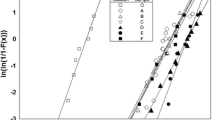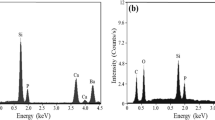Abstract
The production of porous ceramics for biomedical applications is widely available in the Ceramics industry. In bioceramic applications, interconnected pores are pertinent to increase osteoconductivity and cell proliferation. However, an increase in pore size and the pore amount decrease the mechanical properties. For this reason, pore properties must be precisely controlled. In this study, the effect of a natural pore-forming agent, corn starch addition, and sintering conditions on mechanical properties and biocompatibility was investigated. During mixing, four different starch amounts (1, 3, 5, and 10 wt%) were added to pure beta-tricalcium phosphate (β-TCP) ceramic powders and pressed. Pressed pellets were sintered at 1000, 1100, 1200, and 1300 °C. A scanning electron microscope (SEM) is used to investigate microstructure, texture, pore size, and cell adhesion. The mechanical properties of the β-TCP ceramic parts were further characterized by measuring the density and compressive strength. Cytotoxicity tests were carried out with MTT assays. The optimum mechanical properties were obtained at 1100 °C sintered biocomposites. Although starch starts to burn around 410 °C and analytical results show no presence of starch after the sintering process, biocomposites initially containing 10% starch showed improved cell proliferation. However, a reduction of 59% in compressive strength and a 16% reduction in the density were also recorded. It was observed that 10 wt% starch addition increases cell proliferation by 10% in sintered β-TCP samples. Starch powder additions can be used to increase the cell viability of the material by facilitating the creation of pores, as a low-cost pore-forming agent for porous bone graft and non-load-bearing material in both orthopaedics and maxillofacial applications.
Graphical abstract








Similar content being viewed by others
References
Suchanek, W., Yoshimura, M.: Processing and properties of hydroxyapatite-based biomaterials for use as hard tissue replacement implants. J. Mater. Res. 13(1), 94–117 (1998). https://doi.org/10.1557/JMR.1998.0015
Eliaz, N., Metoki, N.: Calcium phosphate bioceramics: a review of their history, structure, properties, coating technologies and biomedical applications. Materials (Basel). 10(4), 334 (2017). https://doi.org/10.3390/ma10040334
Agarwalla, A., Puzzitiello, R., Garcia, G.H., Forsythe, B.: Application of a beta-tricalcium phosphate graft to minimize bony defect in bone–patella tendon–bone anterior cruciate ligament reconstruction. Arthrosc. Tech. 7(7), e725–e729 (2018). https://doi.org/10.1016/j.eats.2018.03.009
Roberts, T.T., Rosenbaum, A.J.: Bone grafts, bone substitutes and orthobiologics. Organogenesis. 8(4), 114–124 (2012). https://doi.org/10.4161/org.23306
Liu, B., Lun, D.X.: Current application of β-tricalcium phosphate composites in orthopaedics. Orthop. Surg. 4(3), 139–144 (2012). https://doi.org/10.1111/j.1757-7861.2012.00189.x
Costantino, P.D., et al.: Sphenoethmoid cerebrospinal fluid leak repair with hydroxyapatite cement. Arch. Otolaryngol. Head Neck Surg. 127(5), 588–593 (2001). https://doi.org/10.1001/archotol.127.5.588
Daculsi, G., Bouler, J.M., Legeros, R.Z.: Adaptive crystal formation in normal and pathological calcifications in synthetic calcium phosphate and related biomaterials. Int. Rev. Cytol. 172, 129–191 (1997). https://doi.org/10.1016/s0074-7696(08)62360-8
Mastalska-Popławska, J., Sikora, M., Izak, P., Góral, Z.: Applications of starch and its derivatives in bioceramics. J. Biomater. Appl. 34(1), 12–24 (2019). https://doi.org/10.1177/0885328219844972
Horstmann, S.W., Lynch, K.M., Arendt, E.K.: Starch characteristics linked to gluten-free products. Foods. 6(4), 1–21 (2017). https://doi.org/10.3390/foods6040029
Gregorová, E., Zivcová, Z., Pabst, W.: Starch as a pore-forming and body-forming agent in ceramic technology. Starch/Staerke. 61(9), 495–502 (2009). https://doi.org/10.1002/star.200900138
Lyckfeldt, O., Ferreira, J.M.F.: Processing of porous ceramics by ‘starch consolidation. J. Eur. Ceram. Soc. 18(2), 131–140 (1998). https://doi.org/10.1016/s0955-2219(97)00101-5
Taherimehr, M., Bagheri, R., Taherimehr, M.: In-vitro evaluation of thermoplastic starch/beta-tricalcium phosphate nano-biocomposite in bone tissue engineering. Ceram. Int. 47(11), 15458–15463 (2021). https://doi.org/10.1016/j.ceramint.2021.02.111
Nakahira, A., Honda, Y., Ohta, M.: Preparatıon and evaluatıon of porous β-TCP based composıtes by green process. Phosphorus Res. Bull. 17, 191–196 (2004). https://doi.org/10.3363/prb1992.17.0_191
Gunduz, O., et al.: Preparation and evaluation of cerium oxide-bovine hydroxyapatite composites for biomedical engineering applications. J. Mech. Behav. Biomed. Mater. 35, (2014). https://doi.org/10.1016/j.jmbbm.2014.03.004
Bas, M., et al.: Mechanical and biocompatibility properties of calcium phosphate bioceramics derived from salmon fish bone wastes. Int. J. Mol. Sci. 21(21), 1–14 (2020). https://doi.org/10.3390/ijms21218082
Sader, M.S., Legeros, R.Z., Soares, G.A.: Human osteoblasts adhesion and proliferation on magnesium-substituted tricalcium phosphate dense tablets. J. Mater. Sci. Mater. Med. 20(2), 521–527 (2009). https://doi.org/10.1007/s10856-008-3610-3
Yetmez, M.: Sintering behavior and mechanical properties of biphasic calcium phosphate ceramics. Adv. Mater. Sci. Eng. (2014). https://doi.org/10.1155/2014/871749
Ruys, A.J., Wei, M., Sorrell, C.C., Dickson, M.R., Brandwoods, A., Milthomes, B.K.: Sintering effects on the strength of hydroxyapatite. Biomaterials. 16(5), 409–415 (1995)
Batool, S., Liaqat, U., Hussain, Z., Sohail, M.: Synthesis, characterization and process optimization of bone whitlockite. Nanomaterials. 10(9), 1–14 (2020). https://doi.org/10.3390/nano10091856
Rangavittal, N., Landa‐Cánovas, A.R., González‐Calbet, J.M., Vallet‐Regi, M.: Structural study and stability of hydroxyapatite and ?-tricalcium phosphate: two important bioceramics. J. Biomed. Mater. Res. 51(4), 660–668 (2000)
Jarcho, M., Salsbury, R.L., Thomas, M.B., Doremus, R.H.: Synthesis and fabrication of β-tricalcium phosphate (whitlockite) ceramics for potential prosthetic applications. J. Mater. Sci. 14(1), 142–150 (1979). https://doi.org/10.1007/BF01028337
Lagier, R., Baud, C.A.: Magnesium whitlockite, a calcium phosphate crystal of special interest in pathology. Pathol. Res. Pract. 199(5), 329–335 (2003). https://doi.org/10.1078/0344-0338-00425
de Oliver Castro, L.: Synthesis and cytotoxicity evaluation of granular magnesium substituted β-tricalcium phosphate. J. Appl. Oral Sci. 21(1), 37–42 (2013). https://doi.org/10.1590/1678-7757201302138
Gallinetti, S., Canal, C., Ginebra, M.P.: Development and characterization of biphasic hydroxyapatite/β-TCP cements. J. Am. Ceram. Soc. 97(4), 1065–1073 (2014). https://doi.org/10.1111/jace.12861
Sahin, Y.M., Orman, Z., Yucel, S.: In vitro studies of α-TCP and β-TCP produced from Clinocardium ciliatum seashells. J. Aust. Ceram. Soc. 56(2), 477–488 (2020). https://doi.org/10.1007/s41779-019-00355-1
Destainville, A., Champion, E., Bernache-Assollant, D., Laborde, E.: Synthesis, characterization and thermal behavior of apatitic tricalcium phosphate. Mater. Chem. Phys. 80(1), 269–277 (2003). https://doi.org/10.1016/S0254-0584(02)00466-2
Meejoo, S., Maneeprakorn, W., Winotai, P.: Phase and thermal stability of nanocrystalline hydroxyapatite prepared via microwave heating. Thermochim. Acta. 447(1), 115–120 (2006). https://doi.org/10.1016/j.tca.2006.04.013
Murphy, C.M., O’Brien, F.J.: Understanding the effect of mean pore size on cell activity in collagen-glycosaminoglycan scaffolds. Cell Adhes. Migr. 4(3), 377–381 (2010). https://doi.org/10.4161/cam.4.3.11747
Author information
Authors and Affiliations
Corresponding author
Ethics declarations
Competing interests
The authors declare no competing interests.
Additional information
Publisher’s note
Springer Nature remains neutral with regard to jurisdictional claims in published maps and institutional affiliations.
Rights and permissions
About this article
Cite this article
Turan, Y., Kalkandelen, C., Palaci, Y. et al. Synthesis and cytotoxicity analysis of porous β-TCP/starch bioceramics. J Aust Ceram Soc 58, 487–494 (2022). https://doi.org/10.1007/s41779-022-00702-9
Received:
Revised:
Accepted:
Published:
Issue Date:
DOI: https://doi.org/10.1007/s41779-022-00702-9




